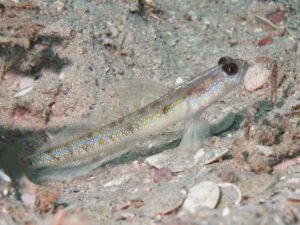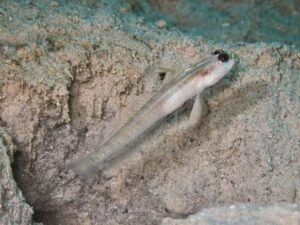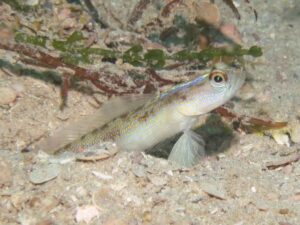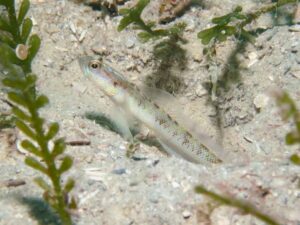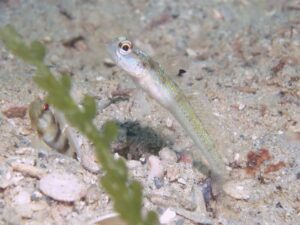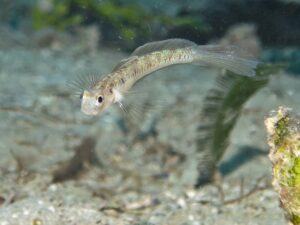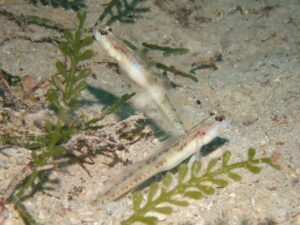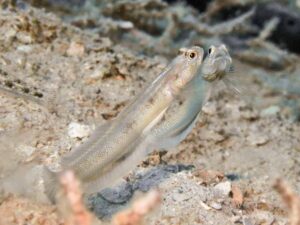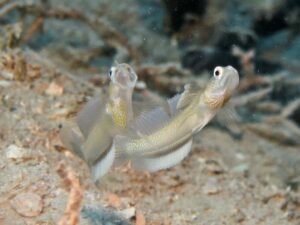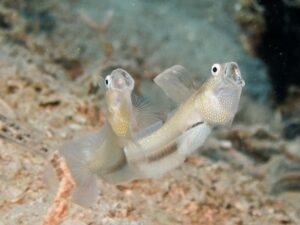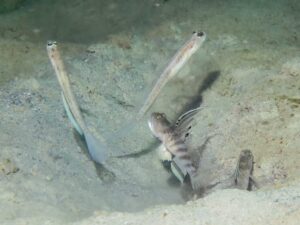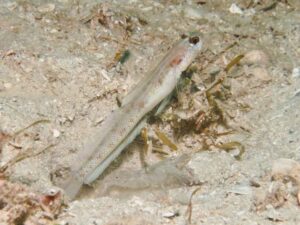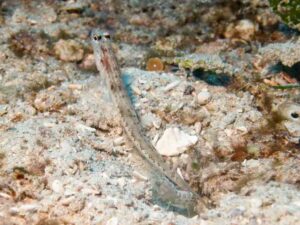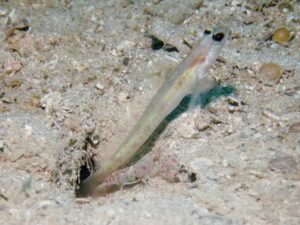Dorsal Spot Shrimpgoby
Vanderhorstia dorsomacula
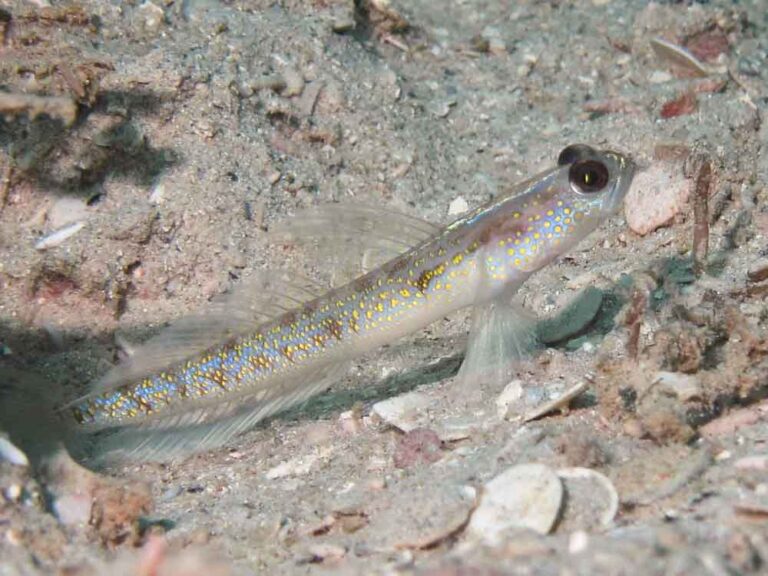
Dorsal Spot Shrimpgoby
Vanderhorstia dorsomaculata
Randall, 2008
Description
Body design
A medium-sized goby, growing to 7 cm. The background colour is pale grey covered with a delicate mosaic of yellow and blue spots. The mid-lateral zone is darker, a stripe made up of a line of inverted triangles of diagonally alternating dark brown and yellow scales. Below this zone, the body is pale from nose to tail. Above the body is decorated with a variable mosaic of brown, blue and gold scales with a line of about ten dorsal saddles. At the level of the first dorsal fin the blue and yellow spots are not arranged into any pattern but rarely they may coalesce into about 5 irregular vertical streaks
The female differs in having the anterior part of the body paler with indistinct markings.
Head design
The top of the head is brown with an iridescent blue line from the nose to the first dorsal fin. The cheek is iridescent blue covered in dark-edged yellow spots that extend over the gill cover to the origin of the pectoral fin. there is a faint streak along the upper lip from below the eye to the level of the nostril.
Fin design
The first dorsal fin is a tall triangle with the fourth and fifth spines longest. It is plain and translucent. A black spot in the mid portion posteriorly is described and illustrated in the type description ( Randall 2008 ) as a male characteristic but we find it is very faint or absent in most cases. The second dorsal fin is blue-grey with a basal row of yellow spots and a dull yellow submarginal line below a slightly reflective edge. The caudal fin is long, and blue with yellow rays. The anal fin is yellow at the base with a dark brown stripe proximally, then blue with faint yellow spots and a darker blue border. The pelvic fins are translucent yellow. The pectoral fins are transparent.
Diagnostic features
This shrimp goby is characterised by a pale body liberally covered in yellow and blue reflective spots which may be uniformly spaced or gathered into 6 to 8 loose clusters.
This species is easily confused with V belloides but the markings below the first dorsal fin may be helpful. The blue and yellow spangles and the blue line anterior to the dorsal fin are characteristic of this species but may occur in either species.
Similar species
V nobilis are similar, the colour patterns are the most reliable way of distinguishing these species.
V dorsomacula lacks the characteristic blue edge brownish orange stripes on the side. Instead, it has numerous small yellow-orange spots. The cheeks and operculum are also profusely covered with similar spots rather than the less numerous larger spots bands and bars of V nobilis. Further differences include the lack of a dark sub-marginal band on the anal fin and black or orange spots on the pelvic fins in V dorsomacula. The first dorsal fin of V nobilis is roughly triangular (with a rounded apex in adult males) compared to the squarish shape of V dorsomacula (Allen and Randall 2006).
Taxonomy
Formerly called Vanderhorstia mertensi. However, this species is restricted to the Red Sea and Mediterranean Sea.
Natural History
Habitat
We have foundVanderhorstia dorsomacula mostly at 18 to 30 m depth. They are usually in fine sand and silt substrate, and sometimes in Halophila sea-grass beds.
Behaviour
Like most Vanderhorstia species they hover above the burrow. They display with widely gaping mouths and all fins fully extended. The images show a pair displaying. It was unclear whether they were a pair or rivals. The latter seems more likely.
Published distribution
Asian Pacific. Indonesia (Bali, Flores, West Papua), Philippines (Calamianes Islands), Papua New Guinea (Madang), Ryukyu Islands, Japan.
Our records. (Range extensions)
Papua New Guinea; Normanby Island.
Solomon Islands; Gizo and Kolombangara Islands
Australia; Lizard Island and Low Isles.
Associated Shrimp species
Associated Shrimps (three shrimps)
Diagonal Barred Snapping Shrimp, Alpheus rapacida
Mottled Spot-tail Snapping Shrimp, Alpheus species 7
Red-Speckled Snapping Shrimp, Alpheus species 10

